Thursday Oct. 19, 2006
The 1S1P Assignment #2a reports were
collected today. The Assignment
#2b reports are due next
Tuesday. Remember you can only do a maximum of two reports as
part of Assignment #2.
Two more Optional Assignments were
handed out in class today. They are both due next Thursday, Oct.
26.
The Reading Assignments page has
been updated.
Here
are
the two remaining humidity example problems that we didn't have time
for last Tuesday.

In the 3rd problem we are given RH=50% and r=10.5
g/kg. We are supposed to determine the air temperature and the
dew point temperature.
The air contains 10.5 g/kg of water vapor, this is 50% of what the air
could potentially hold. So the air's capacity, the saturation
mixing ratio must be 21 g/kg (you can either work this out in your head
or use the relative humidity formule).
Once you know the saturation mixing
ratio you can look up the air temperature in a table. Then you
imagine cooling the air until the RH becomes 100%. This occurs at
60 F. The dew point is 60 F.
Now
the
4th and last problem. We're given an air temperature
of 90 F and a dew point temperature of
50 F. We need to determine the mixing ratio and the relative
humidity.
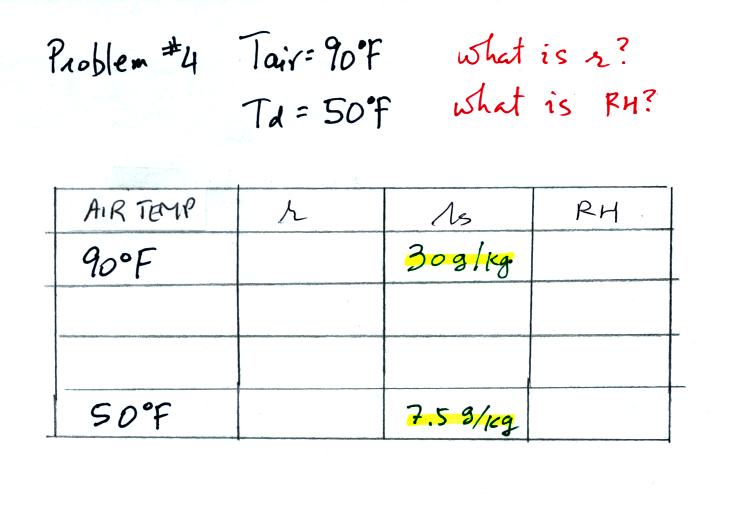
We enter the two temperatures onto a chart and look up
the
saturation
mixing ratio for each.

Then we know that if we cool the 90 F air to 50 F the
RH
will
become
100%. Since we know the saturation mixing ratio value at 50 F is
7.5 g/kg we can say the mixing ratio is 7.5 g/kg.

Remember back to the three earlier examples. When we
cooled air
to the the dew point, the mixing ratio didn't change. So the
mixing ratio must have been 7.5 all along. Once we know the
mixing ratio in the 90 F air it is a simple matter to calculate the
relative humidity.
No we'll
use air with the same characteristics as in the last problem and see
how it is possible to dry out moist air.
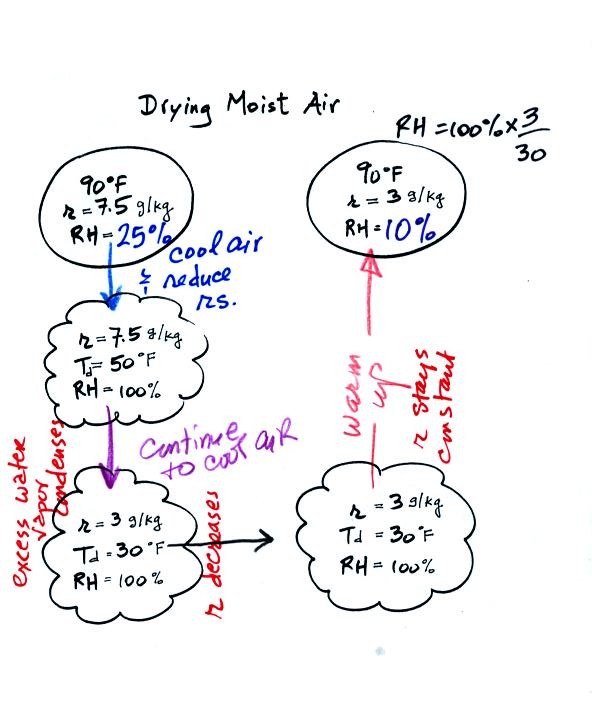
We imagine cooling the moist air to its dew point. The
relative
humidity
reaches 100% at that point. Then the air is cooled below the dew
point, to
30 F. The 30 F air can't hold the 7.5 g/kg of water vapor that
was originally found in the air. The excess moisture must
condense (we will assume it falls out of the air as rain or
snow). When air reaches 30 F it contains less than half the
moisture (3 g/kg) that it originally did (7.5 g/kg). Next the 30
F air is warmed back to 90 F, the starting temperature. The air
now
has a RH of only 10%.
Drying moist air is like wringing moisture from a wet sponge.

Cooling moist air below the dew point is kind of
like squeezing out or wringing out a wet sponge. You start to
squeeze the sponge and nothing happens at first (that's like cooling
the air, the mixing ratio stays constant as long as the air doesn't
lose any water vapor). Eventually water will start to drop from
the sponge (with air this is what happens when you reach the dew point
and continue to cool the air below the dew point). Then you let
go of the sponge and let it expand back
to its orignal shape and size (the air warms back to its original
temperature). The sponge (and the air) will be drier than when
you started.
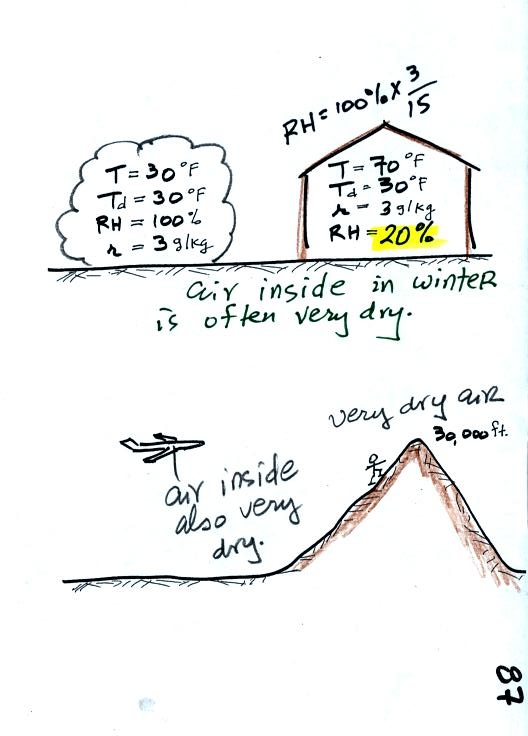
These two figures show where this kind of thing can
occur. In the
winter cold air is brought inside your house or apartment and
warmed. Imagine 30 F air with a RH of 100 % brought inside and
warmed to 70 F. The RH will decrease to 20%.
The air in an
airplane comes from outside the plane. The air outside the plane
is very cold (-50 F perhaps) and contains very little water
vapor (even if the -50 F air is saturated it will contain essentially
no water vapor). When brought inside and warmed to a
comfortable
temperature the RH of the air in the plane will be very close 0%.
Actually I suspect the ventilation system in the plane will add
moisture to the
air so that it doesn't get that dry.
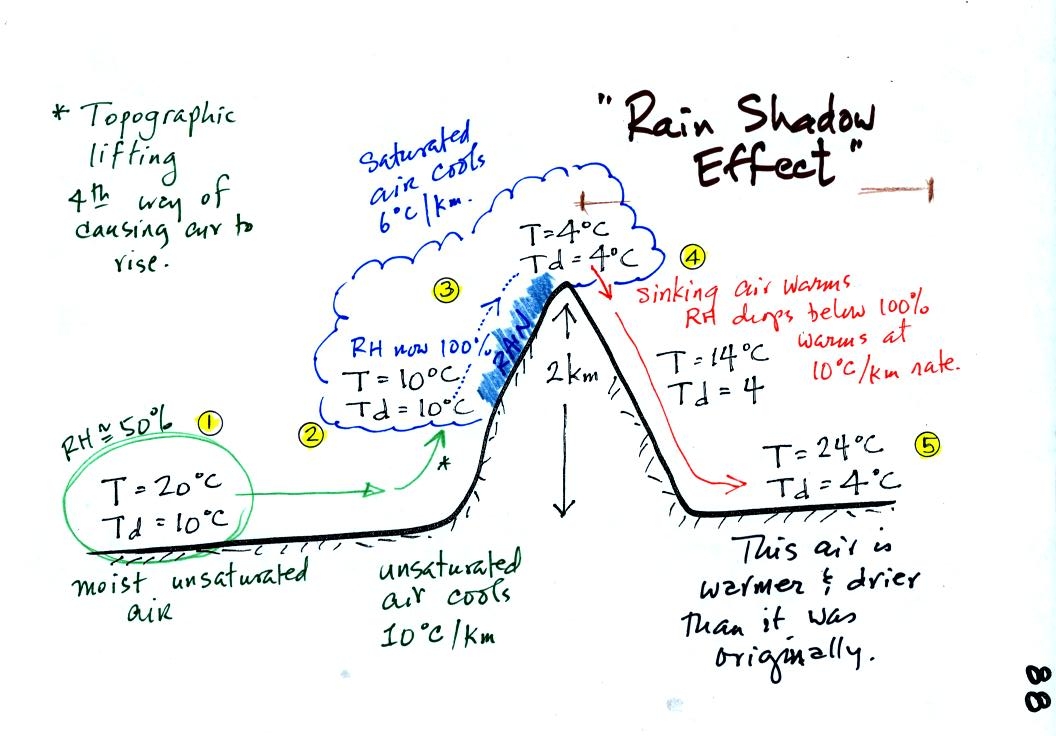
Here's an important cooling and drying out moist
air
example.
We start with some moist but unsaturated air at Point 1 (the numbers were added after class).
As it is moving toward the right the air runs into a mountain and
starts to rise. This is one of the 4 ways of causing air to rise
(the other three were convergence, convection, and fronts).
Unsaturated air cools 10 C for every kilometer of altitude gain.
This is known as the dry adiabatic lapse rate. So in rising 1 km
the air will cool to its dew point.
The air becomes saturated at Point 2, you would see a cloud
appear. Rising saturated air cools at a slower rate than
unsaturated air. We'll use a value of 6 C/km (an average value
for the moist adiabatic lapse rate). The air cools from 10 C to 4
C in next kilometer up to the top of the mountain. Because the
air is being cooled below its dew point at Point 3, some of the water
vapor will condense and fall to the ground as rain.
At Point 4 the air starts back down the right side of the
mountain. Sinking air warms. As soon as the air starts to
sink and warm, the relative humidity drops below 100% and the cloud
evaporates. The sinking air will warm at the 10 C/km rate.
At Point 5 the air ends up warmer (24 C vs 20 C) and drier (Td =
4 C vs Td = 6 C) than when it started out. The downwind side of
the mountain is referred to as a "rain shadow" because rain is less
likely there than on the upwind side of the mountain.
The air that arrives in Arizona from the west coast is often dry
because it has travelled up and over the Sierra Nevada mountains in
California and the Sierra Madre mountains further south in Mexico.
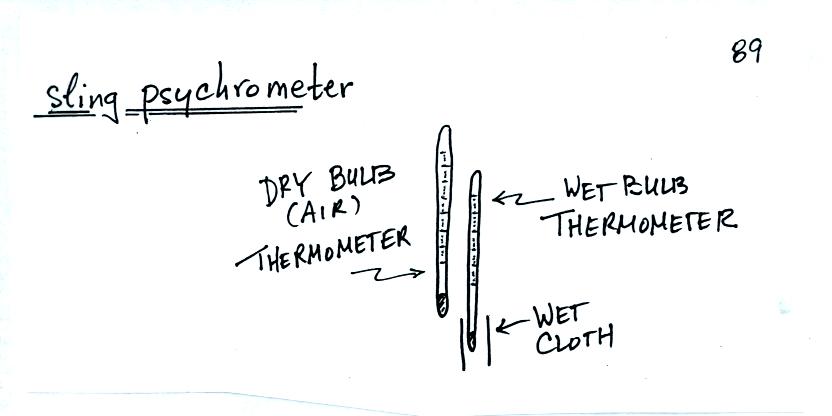
Here's an instrument that can be used to measure humidity, usually
the relative humidity and the dew point temperature. A sling
psychrometer consists of two thermometers mounted
side by side. One is covered with a wet piece of cloth. To
make a humidity measurement you swing the psychrometer around for a
minute or two and then read the temperatures from the two
thermometers. This is an expanded and enhanced version of what is
found on p. 89 in the photocopied class notes.
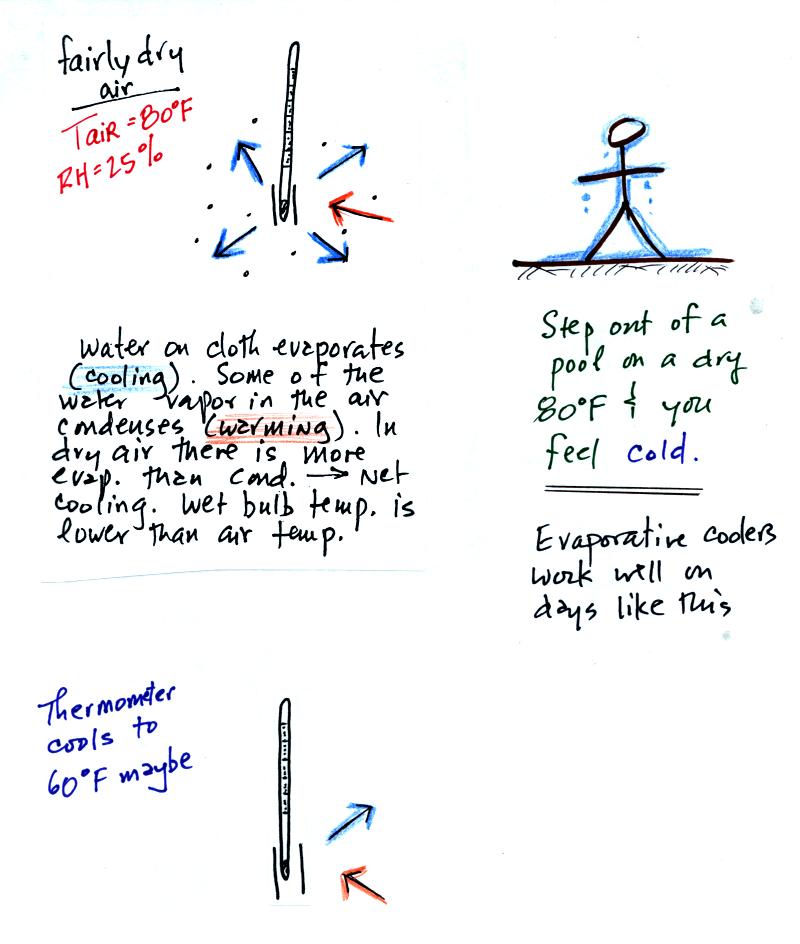
On a warm dry day there will be a large difference (20 F in this
example) between the dry and
wet bulb thermometer readings.
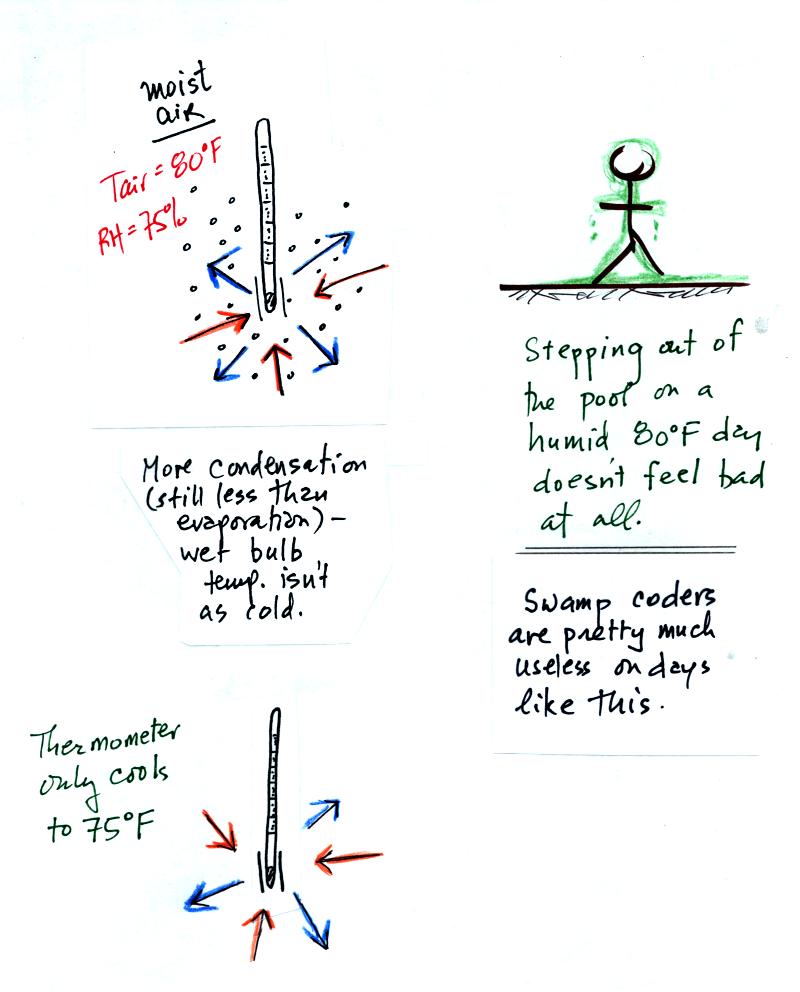
The difference between the dry and wet bulb thermometers will be
smaller on a humid day (only 5 F here).
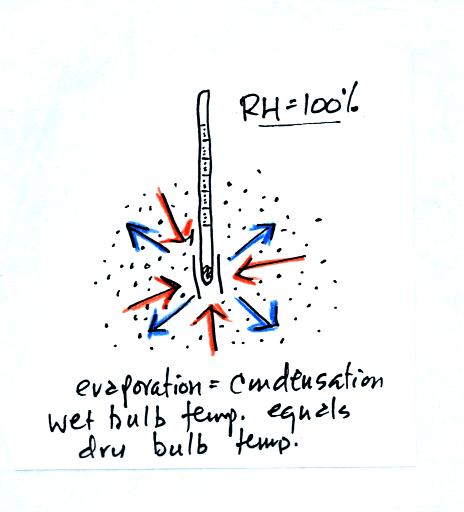
There won't be any difference in temperatures when the RH=100%.
When you
cool air that is next to the ground to the dew point, water
vapor condenses onto objects on the ground such as blades of grass,
your automobile, your morning newspaper, maybe even your sleeping cat.

In the first example air starts out with a
temperature
of 65 F early in the evening. It cools to 35 F during the
night. When the air reaches 40 F, the
dew point, the RH reaches 100%. As the air temperature drops
below the dew point and cools to 35 F water vapor will condense onto
the ground or objects on the ground (such as an automobile). This
is dew.
The dew point is the same but the nighttime minimum temperature
is below freezing in the second example. Dew will form again on
this night when the
air temperature reaches 40 F. Once the air temperature drops
below 32 F though the dew will freeze and form frozen dew.
In the third example both the dew point and nighttime minimum
temperatures are below freezing. When the air temperature drops
below the dew point, water vapor turns directly to ice (deposition) and
forms frost.
The dew point in this case is sometimes called the frost point.
The air never becomes saturated in the fourth example because the
nighttime minimum temperature never cools to the dew point. You
wouldn't see anything on this night.
When air
above the ground reaches 100% relative humidity it is much easier for
water vapor to condense onto small particles in the air called
condensation nuclei. It would be much harder for the water vapor
to condense and form small drops of pure water. You can learn why
this is true by reading p. 92 in the photocopied class notes.
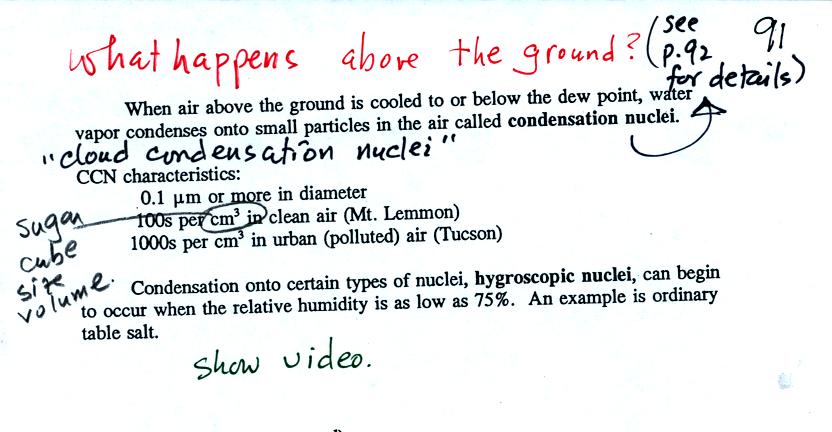
Water vapor will condense onto certain kinds of condensation nuclei
even when the relative humidity is below 100% (again you will find some
explanation of this on p. 92). These are called hygroscopic
nuclei.
A short video showed how water vapor would, over time,
preferentially
condense onto small grains of salt rather than small spheres of glass.
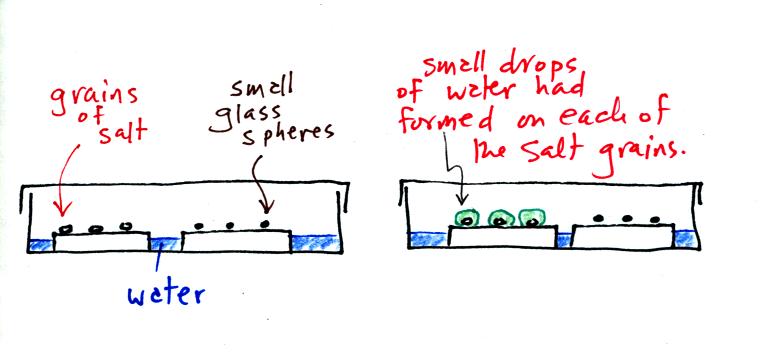
The start of the video at left showed the small grains of
salt were
placed on a platform in a petri dish
containing water. Some small spheres of glass were placed in the
same
dish. After about 1 hour small drops of water had formed around
each
of the grains of salt (shown above at right).
In humid parts of the US, water will condense onto the grains of salt
in a salt shaker causing them to stick together. Grains of rice
apparently will keep this from happening and allow the salt to flow
freely out of the shaker when needed.
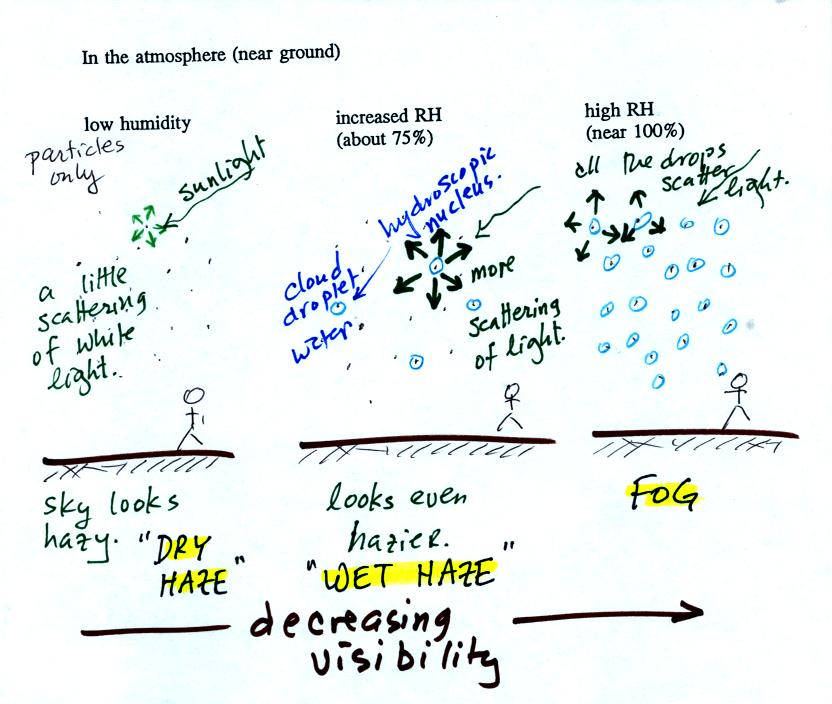
This figure shows how cloud
condensation nuclei and increasing relative humidity can affect the
appearance of the sky and the visibility.
The air in the left most figure is relatively dry. Even though
the condensation nuclei particles are too small to be seen with the
human eye you can tell they are there because they scatter
sunlight. When you look at the sky you see the deep blue color
caused by scattering of sunlight by air molecules together with white
light scattered by the larger condensation nuclei. This changes
the color of the sky from a deep blue to a bluish white
color. The more particles there are the whiter the sky
becomes. This is called "dry haze."
The middle picture shows what happens when you drive from the dry
southwestern part of the US into the humid
southeastern US. One of the first things you would notice is the
hazier
appearance of the air and a decrease in visibility. Because the
relative humidity is high,
water vapor begins to condense onto some of the condensation nuclei
particles (the hygroscopic nuclei) in the air and forms small water
droplets. The water droplets scatter more sunlight than just
small particles alone. The increase in the amount of scattered
light is what gives the air its hazier appearance. This is called "wet
haze."
Finally when the relative humidity increases to 100% fog forms.
Fog can cause a severe drop in the visibility.
We
finished class with a demonstration - we
attempted to make a cloud inside a bottle
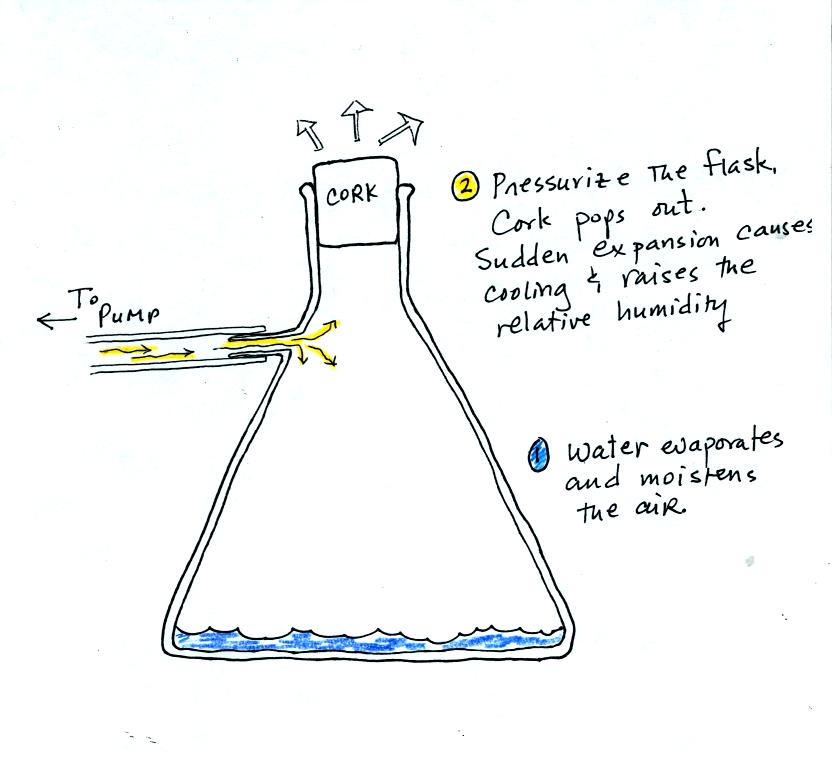
We used a strong thick-walled 4 liter flask. There
was a little
water in the bottom of the flask to moisten the air in the flask.
Next we pressurized the air in the flask. At some point the
pressure blows the cork out of the top of the flask. The air in
the flask expands outward and cools. This cooling increases the
relative humidity of the moist air in the flask to 100% (probably more
than 100%) and water vapor condenses onto cloud condensation nuclei in
the air. A cloud became visible at this point. The
cloud droplets are too small to be seen with the human eye. You
can see the cloud because the water droplets scatter light.

The demonstration was repeated a second time (perhaps a
third time)
with one small change. A burning match was dropped into the
bottle. The smoke from the match consisted of lots of very small
particles that act as condensation nuclei. The cloud that formed
this time was somewhat "thicker" and easier to see.
The following figure wasn't shown in
class (we had run out of time). But I promised I would
stick it onto the end of today's notes.
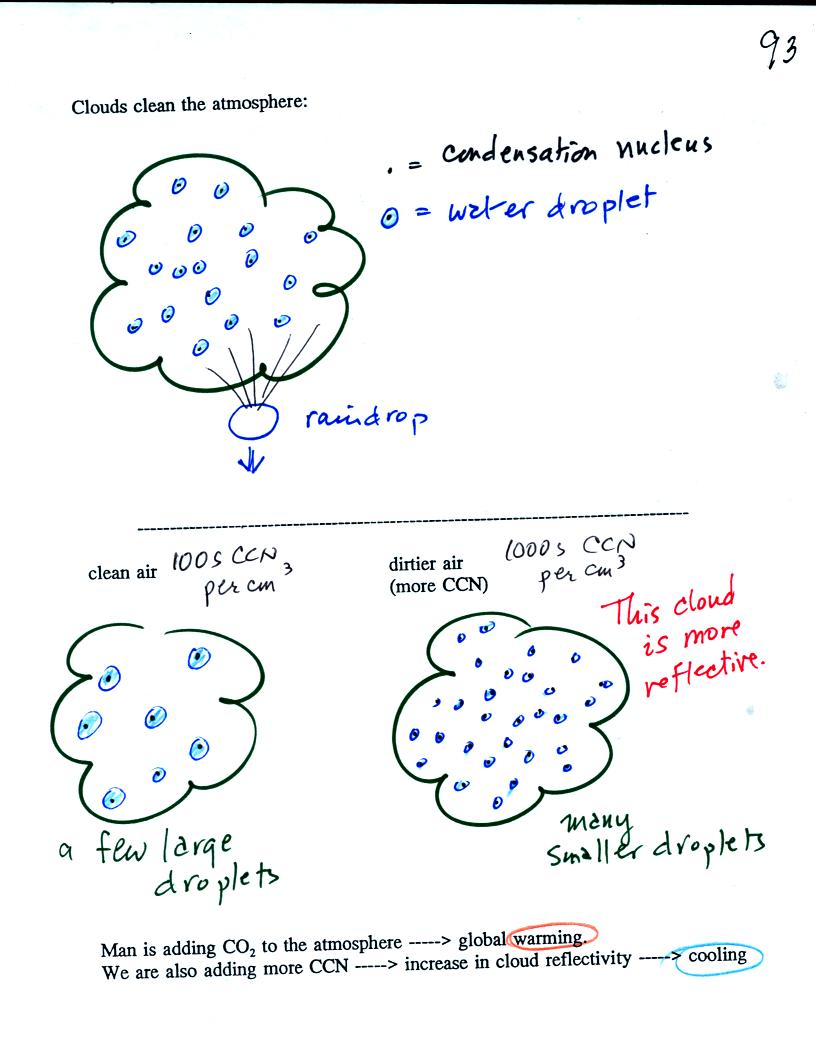
Clouds are one of the best ways of cleaning the atmosphere
(cloud
droplets form on particles, the droplets clump together to form a
raindrop, and the raindrop carries the particles to the ground).
A raindrop contains about 1 million cloud droplets so a single raindrop
can remove a lot of particles from the air. You may have noticed
how clear the air seems the day after a rainstorm. Gaseous
pollutants can dissolve in the water droplets and be carried to
the ground by rainfall also.
A cloud composed of a large number of small droplets is more reflective
than a cloud composed of a smaller number of larger droplets.
This something that interests the people studying climate change.
Combustion of fossil fuels adds carbon dioxide to the atmosphere but
also adds condensation nuclei. The increasing greenhouse gas
concentrations are expected to warm the earth. More particles
might make clouds more reflective though which could cool the earth.


















